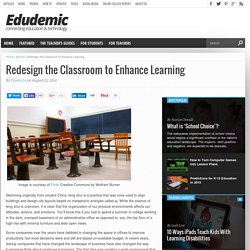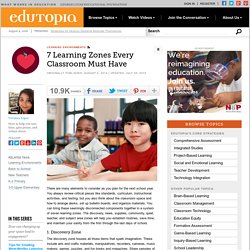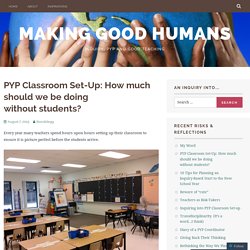

Building Learning Spaces in Unexpected Places. 2015 Innovators Awards Building Learning Spaces in Unexpected Places Austin Community College transformed an aging shopping mall into a revitalized campus hub and high-tech learning lab.

Category: IT Infrastructure and Systems Institution: Austin Community College (TX) Project: Highland Campus ACCelerator. Grand designs: 10 steps to transform your classroom. The start of a new academic year is the perfect time to redesign your classroom.

But before you get carried away – tearing down wall displays and spending a fortune at Ikea – it’s worth taking a little time to consider what you want to achieve. Begin by asking yourself some key questions: what do you want to display on the walls? The future of learning spaces is open ended. By Lucien Vattel August 27th, 2015 Collaboration and creation do not lend themselves to rows of desks.

99% Invisible: A Holistic Approach to Learning Space Design. Part IV of the 99% Invisible series In one of my favorite quotes from The Medium is the Message, Marshall McLuhan wrote, “The serious artist is the only person able to encounter technology with impunity, just because he is an expert aware of the changes in sense perception.”

In other words, since artists fundamentally deal with bending a technology, whether it’s photography, paint, or the violin, they have to be acutely aware of the narrative that that technology produces. Design operates on that same principle. Those who have a comprehensive sense of technology, design, and the narrative it creates, understand how easily that narrative is disrupted, the same way as a dropped note or misplaced brushstroke provokes a jarring departure from the vision that the artist is seeking to convey. Classrooms have a narrative structure that most people don’t see. The narrative of this room is that the action is all in the front. Redesign the Classroom to Enhance Learning. Image is courtesy of Flickr Creative Commons by Wolfram Burner Stemming originally from ancient China, feng shui is a practice that was once used to align buildings and design city layouts based on metaphoric energies called qi.

While the science of feng shui is unproven, it is clear that the organization of our physical environments affects our attitudes, actions, and emotions. You’ll know this if you had to spend a summer in college working in the dark, cramped basement of an administrative office as opposed to, say, the top floor of a high rise with minimal furniture and wide open views. Some companies over the years have dabbled in changing the space in offices to improve productivity, but most decisions were and still are based on available budget.
In recent years, startup companies that have changed the landscape of business have also changed the way businesses think about employee happiness. Classroom Design Matters. As a classroom teacher, one of the most exciting aspects of starting a new school year was organising the classroom learning spaces.

Where would the desks go? Can everyone see the board properly? Can everyone move around the room easily? While I took a great deal of time thinking about the physical objects, I didn’t spend as much time thinking of the use of display areas in my classroom – how students would learn best using the materials selected for display. The classroom environment truly is The Third Teacher.
Future Ready - Internet of Things to Reshape the Workplace. The Internet of Things (IoT) has made its way into the workplace, and is changing the way we do business.

There’s a growing use of beacons, sensors, and ‘smart’ devices that collect data to automate manufacturing, streamline operations, and improve customer experiences. But that’s not enough. We are miles away from reaching a tipping point with IoT. In fact, we are barely scratching the surface of its potential. The workplace of the future is disruptive by nature, led by constant change, and characterized by enhanced connectedness. IoT Rides on the Big Data Wave As we move ahead, there will be a stronger need for businesses to become more perceptive.
IoT makes the capturing and interpretation of raw data more effective. Connectivity will Become Standard Gartner estimated the number of connected devices to reach 26 billion by 2020. 7 Learning Zones Every Classroom Must Have. There are many elements to consider as you plan for the next school year.

You always review critical pieces like standards, curriculum, instructional activities, and testing, but you also think about the classroom space and how to arrange desks, set up bulletin boards, and organize materials. You can bring these seemingly disconnected components together in a system of seven learning zones. PYP Classroom Set-Up: How much should we be doing without students? – Making Good Humans. Every year many teachers spend hours upon hours setting up their classroom to ensure it is picture perfect before the students arrive.

But I wonder, by doing so, are we taking away some great learning opportunities for students? Smaller Spaces, Active Learning. Teaching techniques are shifting from traditional classroom approaches to more diverse, self-guided instruction.

The lecture classroom is being replaced by smaller, multiple spaces that are open, functional, and foster independent learning. Your room design directly influences how well your students are engaged in the classroom. Therefore, as classrooms evolve, our learning environment needs to follow suit. To be effective today, your students need a self-directed and motivating environment. The focus becomes not only what you do as a teacher, but what you do to empower your students to do. Here are some ways that you can inspire and engage your students: 1. Active, engaged classrooms require a stimulating physical environment. 2.
Multiple spaces allow children to self-guide and self-instruct, promoting independence, motivation and discipline. How to Decorate Your Classroom to Maximize Learning. As teachers prepare their classrooms and brainstorm back to school ideas for this year’s learners, they look at those blank walls and bulletin boards and envision the colorful possibilities. It can be loads of fun to create displays and give your classroom life and personality with the materials on your walls. But interestingly, research actually suggests that there are certain types of decorations that supplement daily learning, and certain types of decorations that detract from daily learning. Which ones do you have? Positive Classroom Environment through Classroom Design. The classroom environments teachers create have the potential to play a positive role in learning.
It’s easy to accept the idea that children who attend clean, well-maintained schools have an easier time succeeding than those who don’t. But do the environments teachers create in their classrooms have an impact on their students’ ability to learn? The research says they can. According to Dr. Sheryl Reinisch, director of Early Childhood Education Programs at Concordia University – Portland, studies indicate that high-quality classroom environments “help children feel safe, secure, and valued. The living room effect: ‘When I’m relaxed, I’m more ready to learn’ Dr.
Architecture of Schools: The New Learning Environments - Mark Dudek. Are decorated classroom walls too distracting? Disruptive Decorations. Maps, number lines, shapes, artwork and other materials tend to adorn elementary classroom walls. Heavily Decorated Classrooms Distract Children from Learning.
Tissue paper flowers, banners, rainbow chalkboards, and loads of glitter adorn the walls of many elementary classrooms. While these classroom décor ideas provide hours of entertainment on Pinterest, they probably shouldn’t go any further than a wishful “Pinboard.” A new study, published in Psychological Science, found that children in highly decorated classrooms are more distracted and make smaller learning gains compared to a minimally decorated classroom. Children’s visual environments can affect how much they learn, researchers explain. Therefore, it’s important to maintain focused attention in the classroom since young children usually spend the entire day in that environment.
For the study, 24 kindergarten students were placed in classrooms for six introductory science lessons over the course of 2 weeks. Do classroom decorations disrupt kindergartners’ learning? CHICAGO—To decorate her kindergarten classroom for the new school year, Lori Baker chose cheerful alphabet and number charts featuring smiling children of different races. In the reading corner, she hung three puffy paper flowers from the ceiling and posted dancing letters spelling “Welcome to Kindergarten.” Otherwise, though, the 20-year teaching veteran exercised restraint and deliberately left several walls bare in her room at Whittier Elementary School in Harvey, Ill., a predominately African-American, working-class city about 25 miles south of Chicago.
The latest research suggests she’s onto something. Does the Way Your Classroom Is Decorated Affect Your Learning? - The New York Times. Photo. 10 Apps for Planning a Room Layout — Tablet App Recommendations. Seven Principles for Classroom Design: The Learning Space Rating System. Key Takeaways. Warm, bright, quiet: Students do best in well-designed classrooms.
Landscape for Learning: The Impact of Classroom Design on Infants and Toddlers. LANDSCAPE FOR LEARNING: THE IMPACT OF CLASSROOM DESIGN ON INFANTS AND TODDLERS By Louis Torelli, M.S.Ed., and Charles Durrett, Architect. New Paper: Students Do Best in Well-Designed Classrooms. With so much attention to curriculum and teaching skills to improve student achievement, it may come as a surprise that something as simple as how a classroom looks could actually make a difference in how students learn. Well-designed classrooms can boost learning progress in primary school pupils by16%, new research reveals. Tuesday 24 February 2015. Well designed school classrooms 'boost academic success' Well designed classrooms boost the academic performance of primary school children, a study suggests. Researchers from Salford University said the layout, construction and decoration of classes had a significant impact on reading, writing and maths.
Natural light, temperature, air quality and individualised classroom design were especially important, they said. Room Setup - The School Supply Addict. 36 Clever DIY Ways To Decorate Your Classroom. 21 DIY Ideas for Decorating Your Classroom. What do the best classrooms in the world look like? Imagine if we designed the 21st-century American classroom to be a place where our kids could learn to think, calculate, and invent as well as the students in the top-performing countries around the world.
Classroom design tips. Typically, learning centers are project-based areas to which a student or a few students are directed when they complete assigned work. Study Shows How Classroom Design Affects Student Learning.